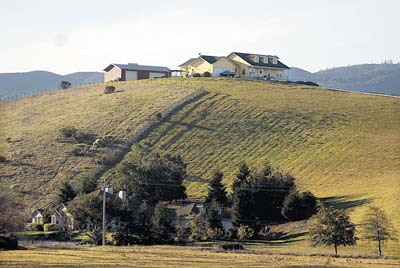
County supervisors today held off on considering
less-restrictive rules in the hillside ordinance and requested that
staff examine whether all homes on slopes should be included or
just some. Supervisors did decide on four corridors that will be
the focus of the ordinance. The hills surrounding Highways 156,
101, 25 (to Panoche Road) and Fairview Road will be subject to
scrutiny under the rules.
HOLLISTER
County supervisors today held off on considering less-restrictive rules in the hillside ordinance and requested that staff examine whether all homes on slopes should be included or just some.
“They want some work done on what we are calling the hybrid ordinance,” County Administrative Officer Susan Thompson said. “This is another attempt at being specific so that people who are building know what they need to do (when building on a hillside).”
Supervisors did decide on four corridors that will be the focus of the ordinance. The hills surrounding Highways 156, 101, 25 (to Panoche Road) and Fairview Road will be subject to scrutiny under the rules.
“It’s going back to the planning commission. The basic work is already done,” Thompson said.
The planning staff for the county presented four options for possible changes, by request of the board at the Jan. 13 meeting. Many of the speakers who addressed the board, meanwhile, contended it would be the best option to preserve aesthetic beauty in the county.
According to the staff report, the first option would amend the applicability to projects located on a 30 percent slope or greater. This option would effectively repeal the old ordinance regulating at the 15-percent level and rely on other regulations to protect the hills.
Option two – which was presented to the board in December 2007 and was rejected – uses the “viewshed” idea and would allow flexibility for housing on hillsides rather than setting limits on criteria such as color, height and size. This option also would balance the interests of the community and the property owner. There would be no limitations on design characteristics.
The third option would be to leave the ordinance “as is” and revisit it when the comprehensive general plan is updated. At that time, alternatives could be discussed.
This option would keep the emphasis on new residential developments within major subdivisions – five or more lots – located on slopes greater than 15 percent.
The final option would be to adopt a hybrid alternative with emphasis being on reviewing projects, visible from the corridors, located on 15 percent slopes. This option would combine options two and three.
Although development on hillsides has continued since the ordinance’s inception, no project in the county has been subject to the guidelines in the ordinance.
As for the new ordinance, it won’t be presented to the board in the near future.
“It’ll be a while before they get it,” Thompson said. “All the detail are not out there yet.”








